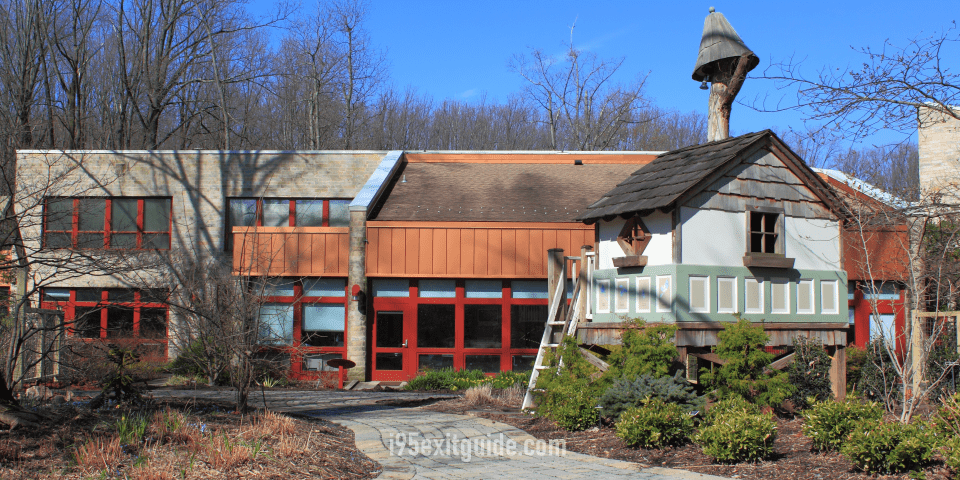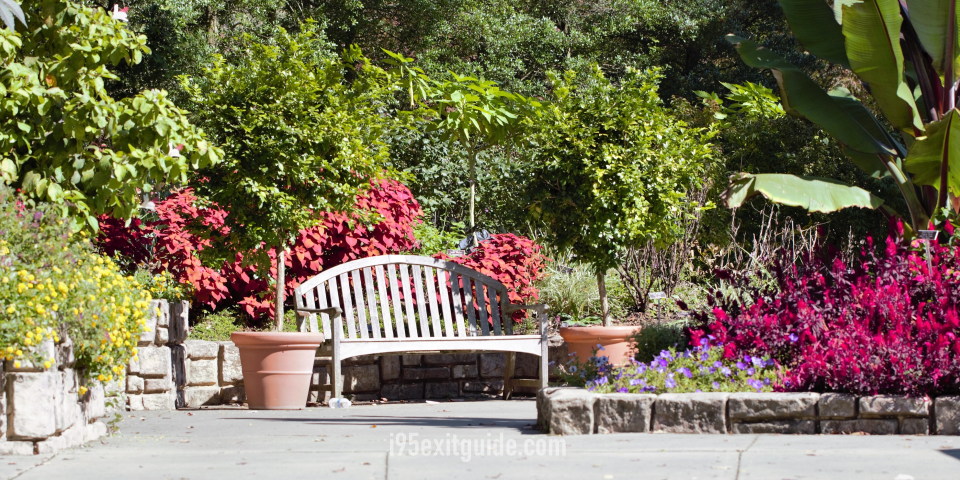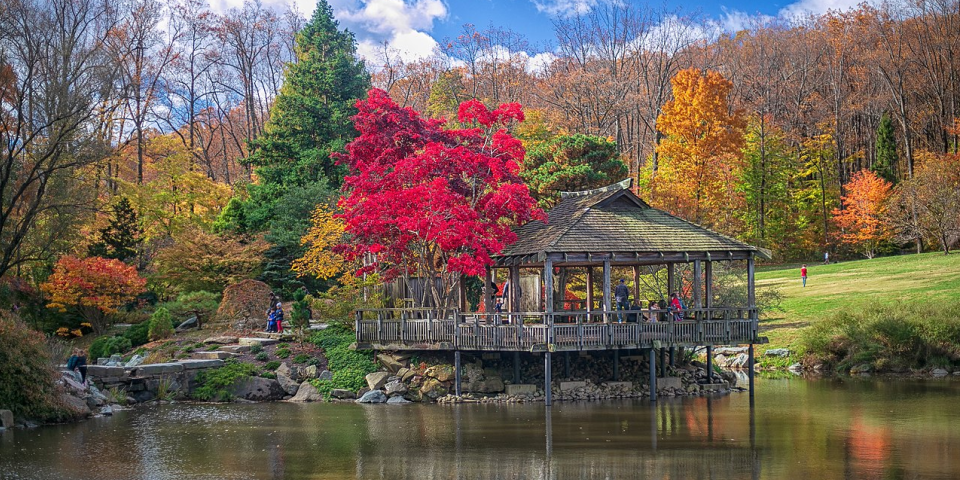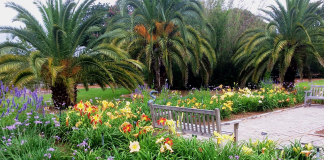Brookside Gardens sits in Wheaton, which is within the greater Silver Spring area of Montgomery County, Maryland.
If you’re driving the I-95 corridor and want a restorative, beautiful, and surprisingly convenient stop, Brookside Gardens is one of the best detours you can make off the highway. It’s a 50-acre public display garden with shimmering ponds, themed garden rooms, woodland walks, and two glass conservatories—plus seasonal attractions like a butterfly house and one of the region’s most beloved winter light displays. It’s part of Wheaton Regional Park, so you also get access to trails, picnic spots, and a nature center right next door. Admission to the outdoor gardens is typically free, parking is free, and you can tailor your visit to anything from a 45-minute leg-stretch to a half-day immersion in flowers, artful design, and gentle, shaded paths.
About Brookside Gardens
Brookside Gardens is a living museum of plants designed as a sequence of “garden rooms.” You move from a Rose Garden to a Japanese-style garden, past water features and shade borders, then on to an Aquatic Garden full of lotus and lilies. It’s carefully curated, but never stuffy; the place is full of life—frogs bask on lily pads, bees hum through lavender, turtles peer from sun-warmed logs.
It’s part of Montgomery Parks and sits within Wheaton Regional Park, so you benefit from well-maintained facilities, an engaged staff, and frequent educational programs. The gardens are layered for four-season interest: spring bulbs and azaleas, summer roses and butterflies, autumn maples and late perennials, winter evergreens and conservatory displays.

History and Background
- History: Brookside Gardens opened to the public in the late 1960s as Montgomery County’s flagship public display garden. Over time it has grown into a sophisticated set of themed spaces with a mission rooted in horticultural excellence, education, and community enjoyment.
- Design philosophy: Instead of botanical garden “collections” that feel like plant lists, Brookside presents living design ideas. Paths curve to reveal framed views; water features bring sound and reflection; long-blooming perennials keep color going between major seasonal peaks; evergreen structure anchors everything. You don’t need to be a landscape designer to feel how well it all hangs together.
- Sustainability: You’ll see rain gardens, native plantings, pollinator-friendly selections, and an emphasis on plant health and diversity. Staff use integrated pest management and horticultural best practices—the gardens aren’t just pretty; they’re models of resilient, regionally adapted planting.
What Makes Brookside Gardens Special!
- Easy, low-cost respite: Outdoor admission and parking at Brookside Gardens are generally free. You can stop, breathe, and recharge without committing to a pricey ticketed venue or a complex city itinerary.
- It’s gorgeous in any season: Tulips and cherry blossoms in spring, lotus blooms and roses in summer, fiery foliage in fall, serene evergreens and indoor tropicals in winter. If your timing aligns, the Garden of Lights holiday event transforms the grounds into a sparkling wonderland; in warm months, the Wings of Fancy live butterfly exhibit is a family favorite.
- It’s welcoming for all travelers: Paved paths, benches, accessible restrooms, and good shade make it friendly for kids, grandparents, and everyone in between. It has enough artful detail to charm garden lovers, and enough simple beauty—trees, water, flowers—to delight anyone who just wants a peaceful place to walk.
- Photographers love it: Reflecting pools, sweeping borders, dramatic plant textures, and seasonal color make for easy, magazine-worthy shots, whether you’re using a phone or a DSLR.
- You’re next door to more fun: Wheaton Regional Park surrounds the gardens with miles of trails, picnic areas, a nature center, and seasonal rides. If you’ve got a little more time, you can pair your garden stroll with a picnic or a short walk in the woods.
Main Highlights
- Visitor Center and Gift Shop: Start here to pick up a map, check on any rotating exhibits or tours, and grab a souvenir. Staff can update you on what’s in peak bloom.
- The Conservatories: Brookside Gardens has two glasshouses offer an immersive plant experience. One features warm, lush tropicals—orchids, palms, bromeliads—and the other leans toward Mediterranean/arid landscapes with citrus, grasses, and succulents. If it’s rainy, cold, or very hot, these indoor spaces deliver color and fragrance year-round.
- Rose Garden: Typically at its most opulent from late spring through early summer, with a flush again in early fall. Expect classic hybrid teas and modern shrub roses, many chosen for disease resistance and fragrance. The design is formal, with symmetrical beds that make it a popular photo spot.
- Aquatic Garden: A signature experience in summer at Brookside Gardens. Big, shallow pools brim with water lilies (Nymphaea) and lotus (Nelumbo) that open in morning light. Dragonflies skim the surface, frogs and turtles pop up, and the reflections are painterly in the late afternoon.
- Japanese-style Garden (often referred to as the Gude Garden): Calm, contemplative pathways curve around water and stone. You’ll see maples, pines, and azaleas, bridges and stepping-stone accents—planted with the measured restraint that makes this style so meditative.
- Perennial and Fragrance Gardens: A changing tapestry of color through the growing season—coneflowers, salvias, ornamental grasses, and plants selected for leaf texture and scent. In the Fragrance Garden, rub a leaf, lean in, and you’ll find a sensory sampler of herbs and aromatic shrubs.
- Azalea and Rhododendron collections: A spring spectacle, often peak late April to early May depending on weather. Massed plantings under high shade create a vibrant woodland wonderland of coral, fuchsia, and white blooms.
- Woodland Walks and Shade Gardens: If you love native plants or just crave a quiet stroll, these paths lead you through understory trees, ferns, and spring ephemerals. Birds are active here; it’s a great spot to listen for woodpeckers and warblers.
- Yew Garden and Formal Terraces: Serene structural plantings offer geometry and evergreen heft that look good even in the depths of winter. These sections photograph beautifully in soft morning light or after a dusting of snow.

Seasonal Attractions
- Wings of Fancy Butterfly and Caterpillar Exhibit: Typically a warm-season, ticketed attraction at Brookside Gardens where you walk through a special greenhouse and butterflies flutter all around you. It’s educational and enchanting—kids and adults both love it. Admission fees and dates vary year to year; check the official site for current details.
- Garden of Lights: A beloved winter tradition with elaborate light sculptures shaped like flowers, insects, and forest creatures. It’s ticketed with timed entry and often sells out around holidays. If you’re passing through late November to early January, this can be the magical capstone to a cold-weather visit.
- Plant sales, tours, and workshops: Throughout the year, the gardens host events ranging from spring plant sales to guided walks and horticulture classes. If you want to learn about native plants, container gardening, or pollinators, you’ll often find something scheduled.
Something for Everyone
- Families with kids: The butterfly house at Brookside Gardens (when open) is a guaranteed hit. The Aquatic Garden offers frogs, fish, and turtles to spot, and the paths are stroller-friendly. While food isn’t allowed inside the formal gardens, you can picnic in Wheaton Regional Park and let kids burn energy at nearby playgrounds. A short drive or walk takes you to the Brookside Nature Center with hands-on exhibits and seasonal programs.
- Couples: The Rose Garden, Japanese-style garden, and tree-shaded benches make for a romantic, unhurried escape. If you’re road-tripping together, it’s an ideal place to stretch legs and reconnect in a calm setting.
- Photographers and artists: Plan your visit at Brookside Gardens around golden hour if possible. In spring, azaleas and bulbs. In summer, lotus blooms and backlit grasses. In fall, maples and reflections. In winter, evergreen structure and the conservatories’ orchids and bromeliads. If you plan a professional photo shoot, check the gardens’ permitting rules.
- Plant geeks: Brookside Gardens’ curators select cultivars for beauty and performance in the Mid-Atlantic climate, and they rotate displays to show design principles—color echoes, foliage contrast, succession planting. You’ll find labels, staff, and often volunteers who can answer questions about cultivars and maintenance practices.
- Road-weary travelers: The gardens are quiet, safe, and easy to navigate. Rest your eyes among greens and blues, stroll by water, sit in shade. You’ll get a real mental reset before you merge back onto the Beltway.
Logistics and Practical Tips
- Parking: Free parking lots serve the main garden and the conservatories. On peak spring weekends or during special events, lots can fill—arrive early or later in the day for easiest access.
- Accessibility: Paths are generally paved or well-compacted and many areas are accessible. There are accessible restrooms and ramps, and benches everywhere. If you or a companion have mobility needs, ask at the Visitor Center about the easiest routes; staff are helpful with maps and suggestions.
- Food and drink: To protect plantings and wildlife, food is not allowed inside the formal gardens, and picnicking is not permitted within the display areas. You can picnic in designated spots within Wheaton Regional Park just outside the garden gates. There are numerous restaurants a short drive away—Wheaton is one of the most diverse dining neighborhoods in the region, with excellent Salvadoran, Peruvian chicken, Ethiopian, Korean, and more.
- Pets: For the health of the gardens and wildlife, pets are not allowed in the formal gardens. Service animals are welcome.
- Photography: Casual photography is welcome; be respectful of plant beds and fellow visitors. Tripods and portrait sessions may be subject to specific rules or permits—check current policies if you’re planning anything beyond casual snapshots.
- Weather and what to wear: Summers can be hot and humid—dress light, bring water, and take advantage of the shade in the woodland sections and conservatories. Spring and fall are prime—layers and comfortable walking shoes are ideal. In winter, bundle up for outdoor structure and then warm up under glass in the conservatories.
Best Times to Visit Brookside Gardens
- Early spring (March–April): Thousands of bulbs—daffodils, tulips, hyacinths—pop across formal beds and lawns. Flowering trees (magnolias, cherries) set the scene, and the fresh, cool air is perfect for longer walks.
- Late spring (April–May): Azaleas hit full swing, rhododendrons follow, and the rose buds swell. The entire garden feels exuberant; weekends get busy, so morning visits are especially lovely.
- Summer (June–August): The Rose Garden is rich, and the Perennial and Fragrance Gardens hum with bees. The Aquatic Garden peaks with lotus and lilies, and the Conservatories offer cool plant-rich retreats. If the butterfly exhibit is on, it’s a must.
- Fall (September–November): Japanese maples blaze, perennial borders glow with late-season asters and grasses, and the air is crisp. It’s an underrated season and a photographer’s dream.
- Winter (December–February): The bones of the garden—evergreens, yews, ornamental bark—come forward. The conservatories keep color and fragrance alive, and if you catch Garden of Lights, you’ll experience the landscape transformed after dark.
How Long to Spend, Depending on Your Schedule
45–60 minutes: Park by the Brookside Gardens Visitor Center. Stroll the central loop: Rose Garden, Perennial/Fragrance Garden, a quick detour to the Aquatic Garden, and back through the Japanese-style garden. Snap a few photos, breathe in the scent of whatever’s blooming, and you’ll feel refreshed.
90 minutes to 2 hours: Add time in the Conservatories, sit a while at the Aquatic Garden, and wander a woodland path. You’ll cover most major highlights without rushing.
Half day: Enjoy a leisurely tour with breaks on the benches, linger for plant labels, take photos, and pair your visit with a picnic in Wheaton Regional Park or a quick stop at the Brookside Nature Center.
Here’s a sample visit for an I‑95 road tripper…
- If you’ve got 90 minutes on a spring morning: Arrive at Brookside Gardens shortly after opening. Park at the main lot and grab a map. Head to the Azalea Garden while the light is gentle, loop past the Rose Garden to see early blooms, and end by the Aquatic Garden. If it’s chilly, warm up in the Conservatories, then rejoin the Beltway refreshed.
- If you’re passing through on a summer afternoon: Start your visit to Brookside Gardens indoors at the Conservatories to escape the heat, then walk to the Aquatic Garden for lotus and dragonflies. Find the Fragrance Garden for aromatic plants, then stroll the Japanese-style garden before heading out. Refuel with a casual meal in Wheaton.
- If it’s a crisp fall day: Focus on the Japanese-style garden and woodland paths for foliage, then the Perennial Garden for late color and grasses. You’ll get shimmering photos, fewer crowds, and perfect road-trip weather.
Details
Address:
Brookside Gardens
1800 Glenallan Avenue
Wheaton, MD 20902
Telephone:
Website:
Hours of Operation:
Outdoor Gardens: open daily 6:30 am – 8:00 pm (sunrise – sunset)
Brookside Gardens Visitor Center: open daily 10:00 am – 2:00 pm
Gift Shop: open Wednesday-Monday 10:00 am – 2:00 pm (Closed Tuesday)
Directions:
From I‑95, you’ll connect to I‑495 (the Capital Beltway) toward Silver Spring. Depending on where you are on I‑95, it’s usually 15–30 minutes from the Beltway to Brookside Gardens, traffic permitting. In practical terms, it’s a short jog off your route that swaps highway noise for birdsong and waterlilies.
Brookside Gardens’ main entrance is on Glenallan Avenue, with another access point near the conservatories. You’ll find ample free parking, clear signage, and a staffed Visitor Center.
Because it’s in the Maryland suburbs rather than downtown D.C., you avoid city driving and parking hassles while still accessing something truly “destination-worthy.”
In short, Brookside Gardens is the ideal I‑95 detour: easy to reach, free to enter outdoors, and deeply satisfying whether you want a gentle stroll beside water or an in-depth exploration of beautifully designed landscapes. It’s big enough to feel like an escape and small enough to enjoy without rushing. From the moment you step onto its paths, the noise of the highway falls away—replaced by the rustle of leaves, the splash of a fountain, and the quiet delight of flowers at their peak. If your road trip could use a pause that feels like a real destination rather than a convenience stop, make Brookside Gardens your garden oasis on the Beltway.
The I-95 Exit Guide is the Internet’s largest and most complete website dedicated to Interstate 95 travelers. Find detailed exit service listings… lodging, camping, food, gas and more for every exit from Maine to Florida!
On the road? Why not take us with you. The I-95 Exit Guide is mobile-friendly and totally FREE. No App Required.
Traveling another route? Visit our growing family of exit guides: I-4 Exit Guide, I-5 Exit Guide, I-10 Exit Guide, I-75 Exit Guide, I-80 Exit Guide and I-95 Exit Guide. Detailed exit service listings… discount lodging, camping, food, gas and more for every exit along the way!












